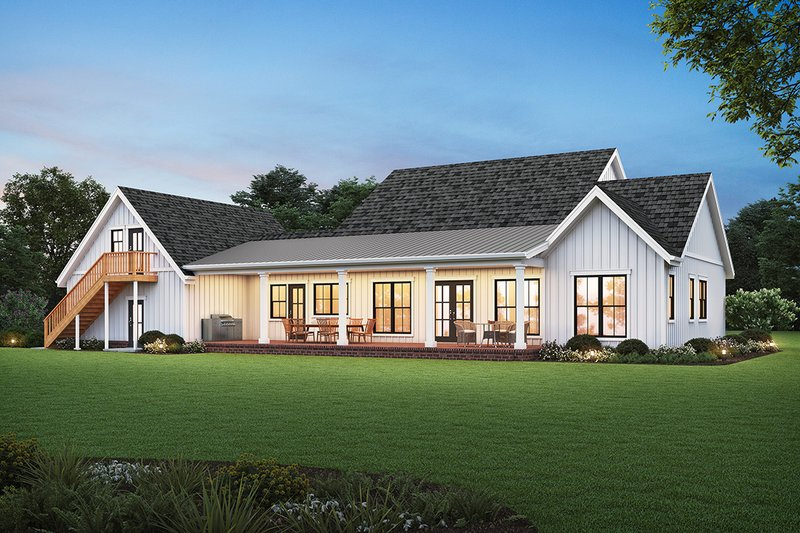Barndominium Plans

It seems you're referring to a page that contains content about barndominium plans from HousePlans.com.
While I can't access the content directly from that link, I can help you understand the concept of barndominiums and how to read barndominium plans based on general principles of floor plans and the specific features that make a barndominium unique.
Barndominium Plans Overview
A barndominium is a blend of a barn and condominium, offering a unique living space that combines the rustic charm of a barn with the comfort and functionality of a modern home.
These structures typically feature open floor plans and large, open spaces that can accommodate both residential and agricultural uses.
Barndominiums are especially popular in rural areas and are often used as weekend homes, workshops, or even fully functional, year-round residences.
Key Features of Barndominium Plans
Open Floor Plan
One of the hallmark features of a barndominium is the open layout.
Barndominium floor plans often have large, unobstructed spaces, with minimal internal walls separating different functional areas such as the kitchen, living room, and dining areas.
This open design is perfect for those who enjoy an airy and spacious feel.
High Ceilings and Loft Spaces
Given that the barndominium often combines the aesthetics of a barn, high ceilings are a common feature in these plans.
Some designs also include lofts or mezzanine areas that can be used as additional bedrooms, storage, or office spaces.
Large Windows and Natural Light
Barndominiums typically feature large windows to let in as much natural light as possible.
This not only adds to the aesthetic appeal but also makes the interior feel even more expansive.
Flexibility in Use
Many barndominiums have flexible floor plans that can be customized to suit a variety of needs.
Whether it’s a workshop space, a large garage, or a home office, these spaces can be adapted easily to fit the buyer's needs.
A large open area can be used for storage, crafting, or even as a small business space.
Agricultural and Industrial Influence
Barndominiums often take inspiration from agricultural and industrial buildings.
This can be seen in features like exposed steel beams, concrete flooring, and steel-framed structures.
The use of durable, long-lasting materials is a key selling point for many who choose this design style.
Energy Efficiency
Many barndominium designs prioritize energy efficiency.
This can include insulation, energy-efficient windows, and solar panel setups, all of which contribute to lower utility bills and a more sustainable living environment.
Deciphering Barndominium Floor Plans
To effectively read and understand barndominium floor plans, it's essential to recognize the unique symbols and layout features typically found in these designs.
Below are some key elements to look for when examining a barndominium plan:
1. Layout & Dimensions
Most barndominium floor plans feature a large central space, often broken down into smaller areas for specific functions like a kitchen, living room, and dining area.
The dimensions of the overall space are important to note as they give a sense of the size and scale of the home.
2. Open Concept
As mentioned earlier, many barndominium plans showcase an open-concept layout.
This means there may be fewer walls dividing rooms, and instead, the spaces will flow seamlessly into one another.
Keep an eye out for the key functional spaces, such as:
Kitchen (often shown as a series of cabinets and appliances like a stove, refrigerator, sink, etc.)
Living area (often indicated with symbols for seating arrangements)
Dining space (represented with a dining table and chairs)
Tip: In some plans, you may see spaces labeled as "great room" or "common area," which typically indicates a large, open room.
3. Loft or Mezzanine
Barndominiums often feature a second-level loft or mezzanine area.
This area could be marked with a dotted line or other symbols, showing how the space is elevated.
These areas can be used for additional bedrooms, an office, or simply for storage.
4. Windows and Natural Light
Large windows are often a signature feature of barndominium plans.
These are represented by thin lines on the plan and typically appear along exterior walls.
In some plans, you may also see window dimensions to help you understand their size and placement.
5. Garage/Workshop Area
A unique aspect of many barndominiums is the inclusion of a large garage or workshop space.
The layout may feature an expansive open area for storing vehicles, machinery, or tools.
These areas are often denoted by large rectangles or squares and may include specific symbols for garage doors or large entry points.
6. Specific Symbols for Fixtures
Just like traditional house plans, barndominium floor plans use specific symbols for fixtures and appliances:
Sinks, bathtubs, and toilets are shown using simple geometric shapes, such as circles or squares.
Appliances like stoves, dishwashers, and refrigerators are often represented with labels and basic geometric shapes (rectangles with specific letters).
Doors and windows are typically marked as blank spaces with arcs to indicate their swing direction.
FAQ:
Q1: What is a barndominium?
A: A barndominium is a type of residential structure that combines the rustic, industrial aesthetic of a barn with the functionality and comfort of a modern home.
It often features open-concept layouts, large living spaces, and a combination of living and working areas, making it a versatile option for rural living.
Q2: How do I read a barndominium floor plan?
A: Reading a barndominium floor plan is similar to reading any house plan.
Focus on key symbols like walls (rectangles), windows (thin lines), doors (blank space or arc), and specific fixtures like sinks, bathtubs, and kitchen appliances.
Pay attention to the open areas and any loft spaces, which are typical in barndominium designs.
Q3: What makes a barndominium different from a traditional home?
A: Barndominiums differ from traditional homes in that they often have an open floor plan with larger, more flexible spaces.
They combine residential living areas with a workshop or storage space and often feature exposed steel, large windows, and high ceilings.
They also typically have a more industrial or agricultural design.
Q4: Can barndominium floor plans be customized?
A: Yes, barndominium plans are highly customizable.
Many builders offer plans that allow you to modify the layout, add or remove walls, and adjust features such as lofts, garage spaces, and kitchen designs.
Some plans also allow for additional customization in the finishes and fixtures used in the home.
Q5: Are barndominiums energy-efficient?
A: Many barndominiums are designed with energy efficiency in mind.
Features like high insulation, energy-efficient windows, and the possibility of adding solar panels make these homes eco-friendly and cost-effective to run.
People Also Ask:
Q1: What are the benefits of a barndominium?
A: Barndominiums offer flexibility in design, large open spaces, and the potential for both residential and work areas.
They are also often more affordable to build than traditional homes and can be energy-efficient with proper insulation.
Q2: How much does it cost to build a barndominium?
A: The cost to build a barndominium varies depending on location, design, and materials used.
On average, costs range from $100 to $200 per square foot, which can be significantly cheaper than building a traditional home.
Q3: What is the difference between a barndominium and a metal building home?
A: A metal building home is a broad category that includes structures made primarily from steel, often with a more utilitarian design.
A barndominium, on the other hand, is a specific type of metal building home that incorporates residential living spaces, often with a more rustic or industrial aesthetic.




